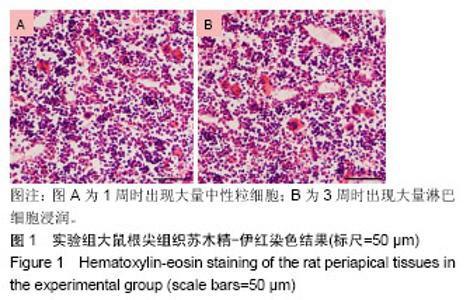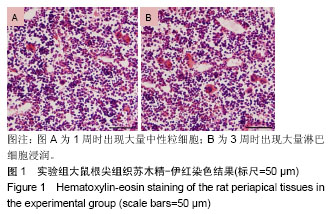| [1] 戴政,张维军,严翔.慢性根尖周炎根管感染病原菌耐药性分析[J].中华医院感染学杂志,2014,24(12):2920-2922.[2] 纪海,李红,侯本祥.微小小单胞菌与慢性根尖周炎临床症状的相关性研究[J].北京口腔医学,2016,24(1):17-20.[3] 王艳青,胡菊花,李颂,等.亲环素A在人根尖周炎中的表达与临床表现的相关性研究[J].牙体牙髓牙周病学杂志, 2015,25(2): 73-99.[4] 邵丽娜,王丝墨,李晓琳,等.mir146a-5p在慢性根尖周炎病损组织中的表达及临床意义[J].口腔医学研究,2017,33(6),650-653.[5] 徐莉雅,马楠,仇丽鸿.慢性根尖周炎中Wnt5a与骨吸收的关系[J].口腔医学研究,2016,32(2):172-176.[6] 王丽娜,叶丹丹,王娇娇,等.NLRP3/Caspase-1炎性体通路在临床慢性根尖周炎病变组织中的表达[J].大连医科大学学报, 2016, 38(6):538-541.[7] 李燕巍,谢广茹,李玲,等.TLR4/MyD88/NF-κB信号通路对LPS诱导的人鼻咽癌5-8F细胞增殖及凋亡的影响[J].临床耳鼻咽喉头颈外科杂志,2015,29(11):1012-1015.[8] Kogut MH, Iqbal M, He H, et al. Expression and function of Toll-likereceptors in chicken heterophils. Dev CompImmunol. 2005;29(9):791-807. [9] Muzio M, Ni J, Feng P, et al. IRAK (Pelle) family member IRAK-2 and MyD88asproximal mediators of IL-1 signaling. Science.1997;278(5343):1612–1615. [10] Burns K, Martinon F, Esslinger C, et al. MyD88, an adapter protein involved ininterleukin-1signaling.J Chem. 1998;273 (20):12203-12209. [11] Beutler B. Inferences, questions and possibilities in Toll-like receptorSignaling.Nature.2004;430(6996):257-263. [12] Dawen L, Shaomian Y. MyD88 expression in the rat dental forosteoclastogenesisand tooth eruption. Eur J Oral Sci. 2010;118(4):333-341. [13] Lucas K, Maes M. Role of the toll like receptor (TLR) radical cycle in chronic inflammation: possible treatments targeting the TLR4 pathway.MolNeurobiol. 2013;48(1):190-204. [14] 方丽娟,孟民杰.髓样分化因子88研究进展[J].广东药学院学报. 2011,27(2):215-217.[15] 雷升萍,王靓,龙子江,等.黄精多糖通过 TLR4-MyD88-NF-κB通路抑制缺氧/复氧H9c2心肌细胞炎性因子释放[J].中国药理学通报,2017,33(2):255-60.[16] 刘海霞.产黑色素类杆菌与慢性根尖周炎临床症状的相关性[J].牙体牙髓牙周病学杂志,2015,25(9):533-541.[17] Jakovljevic A, Knezevic A, Karalic D, et al. Pro-inflammatorycytokinelevels in human apical periodontitis: Correlation with clinical and histological findings.AustEndod J. 2015;41(2):72-77. [18] 沈苏倩,李娟,黄世光.干细胞因子在人慢性根尖周炎组织中表达的研究[J].口腔医学研究,2017,33(2):179-182.[19] Akira S, Takeda K, Kaisho T. Toll-like receptors: critical proteins linking innate andacquired immunity. Nat Immunol. 2001; 2(8):675–680. [20] JanewayCA. Approaching the asymptote Evolution and revolution inimmunology. Cold Spring Harb Sym. 1989;54: 1-13. [21] Akeuchi O, Kawai T, Sanjo H, et al. TLR6 A novel member of an expandingToll2 like receptor family. Gene.1999; 231(1-2): 59-65,767-769. [22] Medzhitov R, Preston-Hurlburt P, Janeway CA. A human homologue of theDrosop-hila Toll protein signals activation ofadaptive immunity. Nature.1997; 388(6640):394-397. [23] 周毅骏,钦丹萍,杨新艳,等.雷公藤多苷片对溃疡性结肠炎大鼠miR-146a、miR-146b及 TLR4/MyD88依赖信号通路的调控作用研究[J].中草药,2016,47(10):1723-1730.[24] 吴健锋,唐朝霞,陈娟,等.严重脓毒症患者外周血单个核细胞Toll样受体2、4和髓样分化因子88在胸腺肽α1治疗过程中的基因表达变化[J].中华普通外科学文献,2014,8(4 ):270-274.[25] 张超男,黄学宽,骆言,等.电针对急性痛风性关节炎大鼠踝关节滑膜组织TLR/MYD88信号通路的影响[J].四川大学学报, 2014, 45(6):924-927.[26] 孟庆胜,纪健,张丽娟,等.TLR4/MyD88依赖性通路和CaVeolin-1的表达与2型糖尿病神经病变患者炎症状态的相关性[J].临床麻醉学杂志,2015,31(5):449-453.[27] Li YW, Xie GR, Li L.The effect of TLR4/MyD88/NF-κB signaling pathway on proliferation and apoptosis in human nasopharyngeal carcinoma 58F cells induced by LPS.J ClinOtorhinolaryngol Head Neck Surg. 2015;29(11): 1012-1015.[28] 陈秀玲,陈秀慧.髓样分化因88在卵巢癌组织中的表达及其临床意义[J].中国临床药理学杂志,2016,32(24):2250-2256.[29] 李晓杰,董明,牛卫东.大鼠实验性根尖周炎中TLR2表达的研究[J].中国微生态学杂志,2016,7(28):767-769.[30] 胡少婷,黄秦,李升锦.髓样化分子88抑制剂ST2825影响重组耻垢分枝杆菌感染的THP-1细胞炎性分泌功能[J].中国微生态学杂志,2014,10(26):1148-1150.[31] Lin X F, Kong JJ, Wu Q Tl.Effect of TLR4/MyD88 signaling pathway on expression of IL1β and TNF-αin synovia fibroblasts from temporomandibular joint exposed to lipopolysaccharide.Mediators Inflamm. 2015;2015:329405.[32] 王敦方,王彦礼,王怡薇,等.黄芩汤对溃疡性结肠炎大鼠TLR4/MyD88通路调控作用研究[J].药学学报. 2016,51(10): 1558-1563. [33] He W, Yu Q, Zhou Z, et al. CpG oligonucleotides induce an immune response of odontoblasts through the TLR9, MyD88 and NF-kappaB pathways. Biochem Biophys Res Commun. 2010;399(2):274-278.[34] He W, Zhang Y, Zhang J, et al. Cytidine-phosphate-guanosine oligonucleotides ind-uce interleukin-8 production through activation of TLR9, MyD88, NF-κB, and ERK pathways in odontoblast cells. J Endod.2012;38(6):780-5. [35] Zhang J, Zhu QL, Huang P, et al. CpG ODN-induced matrix metalloproteinase-13expression is mediated viaactivation of the ERK and NF-κBsignalling pathways inodontoblast cells. IntEndod J.2013;46(7):666-674. [36] Ogawa T, Hashimoto M, Takeuchi O, et al. Cell activation by Porphyromonasgingivalis lipidAmolecule through Toll-like receptor 4-and myeloid differentia-tion factor88- dependentsignaling pathway. Intimmunol. 2002;14(11): 1325-1332. [37] He W, Qu T, Yu Q, et al. LPS induces IL-8 expression through TLR4, MyD88, NF-kappaB and MAPK pathways in human dental pulp stem cells. Int Endod J.2013;46(2):128-136. [38] Wang L, Jin H, Ye D, et al. Enterococcus faecalisLipoteichoic Acid–induced NLRP3 Inflammasome via the Activation of the Nuclear Factor Kappa B Pathway. J Endod. 2016;42(7): 1093-1100. [39] 梅陵宣,刘正,张濒.实验性鼠根尖周炎组织学动态观察[J].实用口腔医学杂志,2002,18(6):500-503.[40] Wang L, Peng B. Correlation between platelet-derived growth factor B chain andbone resorption in rat periapical lesions. J Endod.2007; 33(6):709–711. |







